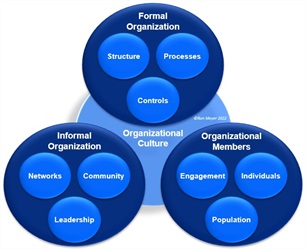Organizational System Map
How can I map the key characteristics of my organization? Ron Meyer presents an insightful tool to kickstart your thinking: Organizational System Map.
Key Definitions
An organization is a group of people acting together to realize a shared objective. In an organization, the necessary work is divided among the organizational members (division of labor or differentiation) and their activities are aligned to jointly achieve the intended results (coordination of labor or integration). Organizing is about how best to differentiate and integrate activities. This can be called the horizontal organization issue, as it is between people. Organizing is also about determining who should steer the activities (control) and how much room members should have to determine actions themselves (empowerment). This can be called the vertical organization issue, as it is about who should have power over whom.
Conceptual Model
The Organizational System Map gives an overview of the key characteristics found in every organization. While organization charts are the most popular way to picture organizations, this model suggests that organizations can be better understood by recognizing four main aspects: their particular design (formal organization), the characteristics growing on top of this formal design (informal organization), the people they have on board (organizational members) and their underlying beliefs, values and norms (organizational culture). These are not parts of the organization, found in a specific place, but aspects found throughout. Note that this model is the third building block of the Strategic Alignment Model (Meyer’s Management Model #32).

Download picture
Key Elements
The four main characteristics of each organization are the following:
1. Formal Organization. All explicitly agreed upon arrangements made between people about how to work together are part of the formal organization. These include:
a. Structure. This details how work is split and assigned to specific people (differentiation) and to whom these people report (control). This is commonly summarized in an orgchart.
b. Processes. These specify how people need to work together to complete multi-stage activities or exchange information (integration). Here RACI models are often used.
c. Controls. These are the instruments used to steer people’s behavior, such as strategic planning and performance management. See Meyer’s Model #11 on the Control Panel.
2. Informal Organization. When coordination between people develops organically, but isn’t formally arranged, we speak of the informal aspects of the organization. These include:
a. Networks. These are all connections established between people that can be used to exchange information, influence decisions, and/or get work done.
b. Community. Even where people are not personally connected, they can experience a sense of belonging, team spirit and mutual responsibility vis-à-vis each other.
c. Leadership. While management is one of the controls, specified in the structure, leadership is the ability to influence others. This needs to grow, despite one’s position.
3. Organizational Members. The people that make up the organization are its members. There are three sub-aspects that need to be considered when looking at them:
a. Individuals. The members can be viewed as a collection of individuals, each with their own personality, knowledge, skills, capabilities, and relationships.
b. Population. The members also need to be viewed collectively to see how diverse and balanced the composition of each part of the organization is.
c. Engagement. The members also need to be viewed as more than a bundle of required resources (hands & heads), recognizing their energy and motivation (hearts & minds).
4. Organizational Culture. Lurking behind the three front disks is the organizational culture. The culture encompasses the shared worldview of the organizational members (their beliefs), the principles they hold dearly (their values) and the unwritten rules of behavior that follow from both (their norms). Culture subtly influences all three other organizational aspects and can only be influenced back via changes to these three.
Key Insights
• Organizations are more than their orgcharts. Organization charts give limited insight into the functioning of organizations, as they only show the (intended) division of labor and reporting lines. How integration and control really (should) happen is not made clear.
• Organizations have four key characteristics. Structure is only one of the three elements making up the formal organization. Equally important for understanding organizations is knowing the informal organization, organizational members, and organizational culture.
• Organizations have a hard and soft side. The top big disk is the engineered, mechanical aspect of the organization, with hard controls and integrators. The bottom three big disks are the human, social aspects, which allow for soft controls and integrators. These soft aspects guide behavior (indirect steering) instead of determining it (direct steering).
• Organizations have a front and back side. The three big disks in front are the tangible and directly influenceable aspects of the organization, while the organizational culture at the back is difficult to observe and only indirectly influenceable via the front three disks.
• Organizations have an adaptive and rigid side. Changing the formal organization is the easiest, while it gets increasingly difficult as you move to the organizational members, the informal organization and ultimately the organizational culture.
Inspired by this kickstart?
The six-day Masterclass Strategic Leadership will teach you how to make well-informed strategic decisions and effectively manage the organization developing its vision. This will help you grow as a strategic thinker and leader. During this masterclass, you will work on solutions for a problem that you bring in from personal experience. In addition, you will reflect on the functioning of your management team and organization and thus help your organization to grow effectively.
Read more about the Masterclass Strategic Leadership »
Organizational System Map is part 34 of a series of management models by prof. dr. Ron Meyer. Ron is managing director of the Center for Strategy & Leadership and publishes regularly on Center for Strategy & Leadership.